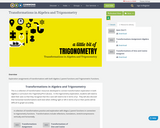
Exploration assignments of transformations with both Algebra 2 parent functions and Trigonometric Functions.
- Subject:
- Algebra
- Mathematics
- Trigonometry
- Material Type:
- Assessment
- Homework/Assignment
- Author:
- Rachel Hyder
- Date Added:
- 08/04/2020

Exploration assignments of transformations with both Algebra 2 parent functions and Trigonometric Functions.

In this students will develop their knowledge of transformations as it applies to all functions. This lesson focuses on linear, quadratic, absolute value, exponential and radical functions. Students will need access to internet and graphing utilities.I have included the assessment I used to asses this unit. See "Resources" tab in the right.
Remix of: AEA Template for Building Lessons
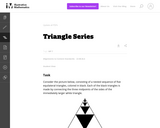
The purpose of this task is to emphasize the adjective "geometric" in the "geometric" series, namely, that the algebraic notion of a common ratio between terms corresponds to the geometric notion of a repeated similarity transformation.
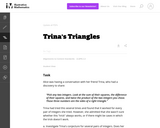
In this task students must investigate this conjecture to discover that it does not work in all cases: Pick any two integers. Look at the sum of their squares, the difference of their squares, and twice the product of the two integers you chose. Those three numbers are the sides of a right triangle.
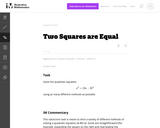
This classroom task is meant to elicit a variety of different methods of solving a quadratic equation (A-REI.4).
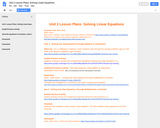
Students will learn how to write linear equations to describe phenomenon. Students will also learn how to solve equations in multiple steps including equations that have no solution or infinitely many solutions.

Students are introduced to algebraic expressions that use more than one variable and have multiple solutions. They figure out combinations of two items at different costs, with each combination adding up to 100.

Prepared with pre-algebra or algebra 1 classes in mind, this module leads students through the process of graphing data and finding a line of best fit while exploring the characteristics of linear equations in algebraic and graphic formats. Then, these topics are connected to real-world experiences in which people use linear functions. During the module, students use these scientific concepts to solve the following hypothetical challenge: You are a new researcher in a lab, and your boss has just given you your first task to analyze a set of data. It being your first assignment, you ask an undergraduate student working in your lab to help you figure it out. She responds that you must determine what the data represents and then find an equation that models the data. You believe that you will be able to determine what the data represents on your own, but you ask for further help modeling the data. In response, she says she is not completely sure how to do it, but gives a list of equations that may fit the data. This module is built around the legacy cycle, a format that incorporates educational research feindings on how people best learn.

Investigate the effect of gravity on objects of various mass during free fall. Predict what the position-time and velocity-time graphs will look like. Compare graphs for light and heavy objects. Was Galileo Right is the last of five SmartGraphs activities designed for a typical physical science unit of study on the motion of objects.
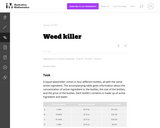
The principal purpose of the task is to explore a real-world application problem with algebra, working with units and maintaining reasonable levels of accuracy throughout.

Students act as food science engineers as they explore and apply their understanding of cooling rate and specific heat capacity by completing two separate, but interconnected, tasks. In Part 1, student groups conduct an experiment to explore the cooling rate of a cup of hot chocolate. They collect and graph data to create a mathematical model that represents the cooling rate, and use an exponential decay regression to determine how long a person should wait to drink the cup of hot chocolate at an optimal temperature. In Part 2, students investigate the specific heat capacity of the hot chocolate. They determine how much energy is needed to heat the hot chocolate to an optimal temperature after it has cooled to room temperature. Two activity-guiding worksheets are included.

Write Systems of Equations using Augmented Matrices
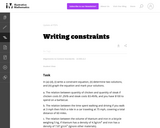
The purpose of this task is to give students practice writing a constraint equation for a given context. Instruction accompanying this task should introduce the notion of a constraint equation as an equation governing the possible values of the variables in question.
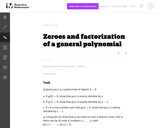
This task looks at zeroes and factorization of a general polynomial. It is related to a very deep theorem in mathematics, the Fundamental Theorem of Algebra, which says that a polynomial of degree d always has exactly d roots, provided complex numbers are allowed as roots and provided roots are counted with the proper "multiplicity.''
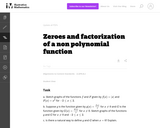
The intention of this task is to provide extra depth to the standard A-APR.2 it is principally designed for instructional purposes only. The students may use graphing technology: the focus, however, should be on what happens to the function g when x=0 and the calculator may or may not be of help here (depending on how sophisticated it is!).
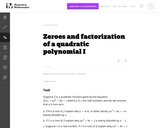
For a polynomial function p, a real number r is a root of p if and only if p(x) is evenly divisible by x_r. This fact leads to one of the important properties of polynomial functions: a polynomial of degree d can have at most d roots. This is the first of a sequence of problems aiming at showing this fact.
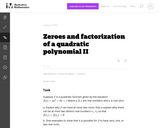
This task continues ``Zeroes and factorization of a quadratic polynomial I.'' The argument here generalizes, as shown in ``Zeroes and factorization of a general polynomial'' to show that a polynomial of degree d can have at most d roots. This task is intended for instructional purposes to help students see more clearly the link between factorization of polynomials and zeroes of polynomial functions.

Students use virtual algebra tiles to add polynomials.

(Nota: Esta es una traducción de un recurso educativo abierto creado por el Departamento de Educación del Estado de Nueva York (NYSED) como parte del proyecto "EngageNY" en 2013. Aunque el recurso real fue traducido por personas, la siguiente descripción se tradujo del inglés original usando Google Translate para ayudar a los usuarios potenciales a decidir si se adapta a sus necesidades y puede contener errores gramaticales o lingüísticos. La descripción original en inglés también se proporciona a continuación.)
El módulo 2 se basa en el trabajo previo de los estudiantes con unidades y con funciones del álgebra I, y con relaciones y círculos trigonométricos de la geometría de la escuela secundaria. El corazón del módulo es el estudio de definiciones precisas de seno y coseno (así como tangente y las cofunciones) utilizando geometría transformacional de la geometría de la escuela secundaria. Esta precisión lleva a una discusión de una unidad matemáticamente natural de medida rotacional, un radian, y los estudiantes comienzan a desarrollar fluidez con los valores de las funciones trigonométricas en términos de radianes. Los estudiantes grafican funciones trigonométricas sinusoidales y otras, y usan los gráficos para ayudar a modelar y descubrir propiedades de las funciones trigonométricas. El estudio de las propiedades culmina en la prueba de la identidad pitagórica y otras identidades trigonométricas.
Encuentre el resto de los recursos matemáticos de Engageny en https://archive.org/details/engageny-mathematics.
English Description:
Module 2 builds on students' previous work with units and with functions from Algebra I, and with trigonometric ratios and circles from high school Geometry. The heart of the module is the study of precise definitions of sine and cosine (as well as tangent and the co-functions) using transformational geometry from high school Geometry. This precision leads to a discussion of a mathematically natural unit of rotational measure, a radian, and students begin to build fluency with the values of the trigonometric functions in terms of radians. Students graph sinusoidal and other trigonometric functions, and use the graphs to help in modeling and discovering properties of trigonometric functions. The study of the properties culminates in the proof of the Pythagorean identity and other trigonometric identities.
Find the rest of the EngageNY Mathematics resources at https://archive.org/details/engageny-mathematics.